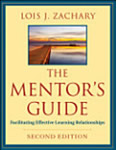The Mentor's Guide: Facilitating Effective Learning Relationships
Lois J Zachary
Publications: John Wiley & Sons; 2nd edition
ISBN-10: 047090772X
ISBN-13: 978-0470907726

Reviewer: Professor M S Rao
“It is the leader’s responsibility to serve as a role model, to mentor the next generation of leaders, and to make sure that continuous opportunities for learning and development are provided.” – Lois J. Zachary
Zachary presents a learning-centred mentoring paradigm with seven critical elements: reciprocity, learning, relationship, partnership, collaboration, mutually defined goals, and development. She unveils that for any mentor it is important to create a learning partnership; help mentees identify goals for learning; negotiate a learning contract; help learners discover what objectives they should set; use multiple modalities and resources to achieve the objectives; manage the learning experience; manage the learning experience; help mentees stay focused on the goals, objectives, and learning strategies; and periodically revisit goals to stay on track.
Zachary says that the learning process has shifted from mentor-directed to self-directed, and the focus of mentoring partnership has shifted from knowledge transfer to critical reflection and application, and mentoring is most successful when it is collaborative. She explains stretch goals, gives pointers for mentoring various cohorts/generations such as boomers, Gen Xers, and Gen Yers and unfolds that today’s learning has become more differentiated. There is a five-step work plan for achieving learning goals, lays out the objectives, identifies ways in which to demonstrate trust-building behaviours, and outlines strategies for successful time management in a mentoring relationship.
Zachary provides some strategies for overcoming obstacles with particularly challenging mentees, such as user mentees; jealous mentees; unfocused mentees; manipulative mentees; submissive mentees; apathetic mentees; and saboteur mentees. She believes that a good mentoring negotiation process will result in well-defined goals; success criteria and measurement; delineation of mutual responsibilities; accountability assurances; a consensual mentoring agreement; and a work plan for achieving learning goals, but cautions that despite the best of intentions, mentoring partners do cross boundaries and limits are tested or exceeded. This can harm the mentoring relationship and negatively affect the learning taking place within it.
The book equips you with exercises, examples, tables and figures to ensure mentoring takeaways quickly. It provides practical tools and techniques, templates and worksheets that guide and help you understand the essence quickly. It contains beautiful stories to quickly connect the reel content with real life events and experiences. For example, she describes Chad, and extravert mentor, and Nate, an introvert mentee. Initially they had several challenges to gel well but subsequently they melded themselves and created compatibility and chemistry to ensure effective mentoring outcomes.
The book is an outstanding resource for educators, managers, leaders and learners.


